
|   |

|   |
Sankaradeva Movement celebrations in Mumbai - Dr. Sunil Kothari e-mail: sunilkothari1933@gmail.com Photos courtesy: Sankaradeva Movement June 8, 2014 Sankaradeva Movement is an attempt to promote Mahapurusha Sankaradeva's philosophy and the culture of Assam. It is an initiative of Trend MMS, the most reputed Socio-Cultural Trust of North Eastern region. They have taken up many initiatives to promote the region. North East Festival is also the initiative of Trend MMS. In November 2013, North East Festival was organized at Indira Gandhi National Centre for the Arts (IGNCA), New Delhi, where 8 State Governments of the region joined hands to promote the region's culture and highlight the various issues. It was the biggest occasion to project regional culture of North East. Earlier, Trend MMS organized 'Samannaya' - a musical journey of integration, wherein leading singers of the state travelled across Assam, especially in the trouble torn BTAD areas to promote harmony. The two earlier events were organized in 2012 at Kamani Auditorium in Delhi and in 2013 at Chowdiah Memorial Hall in Bengaluru. With Taj Mahal Palace, on17th May, Trend MMS organized 'Colours of North East' at Taj Mahal Hotel in Mumbai to showcase tourism, culture and fabrics of the region. On a grand scale, the Sankaradeva Movement celebrations were held on 18th May evening at the prestigious Jamshed Bhabha Auditorium of National Centre for the Performing Arts, when a record crowd of majority of Assamese community and of North East region gathered to support the Sankaradeva Movement. 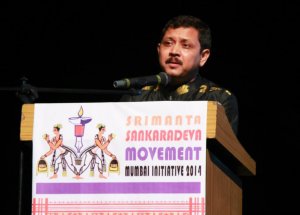 Shyamkanu Mahanta 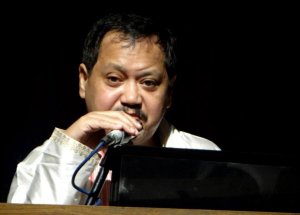 Bhaskar Jyoti Mahanta In the morning at The Little Theatre of NCPA, the governor of Assam Shri Janaki Ballabh Pattanaik presided over the inaugural function. The morning session was devoted to the discussion on the 'Relevance of Sankaradeva in Modern India.' Bhaskar Jyoti Mahanta, a scholar and advisor of the Srimanta Foundation for Culture and Society, Guwahati, with his brother and principal organizer Shyamkanu Mahanta, delivered as a power point presentation an illustrated talk on Sankaradeva Movement as a social bridge. Srimanta Sankaradeva is also known as Mahapurusha. He established an institution of Sattra, monastery in Assam. With Namghar also known as Kirtanghar, the prayer hall, the devotees and the Sattradhikari, head of the Sattras, became the centre stage of all activities in the villages and the interior areas, disseminating the universal ideals of the Vaishnava Movement. As the Sattras expanded their influence on different strata of the society, distinct socio-cultural and economic traditions took deep roots to usher in the liberal social order keeping its spiritual base as an organic unity - an ideal model of an extended family demonstrating its self-sufficient qualities for economic sustainability through its diversified activities. Bhaskar Jyoti Mahanta in his discourse gave most welcome information about the influence of Sankaradeva's philosophy among the various tribes. As an off shoot of this activity Srimanta Sankaradeva Sangh, the largest socio-religious organization of Assam, holds annual conventions connecting people at grassroots level and is to start a private university and a bank. What is fascinating is that there is a huge following of the Mahapurusha amongst the tribal communities in Assam. They have been having a long standing relationship with the Sattra institutions. During Sankaradeva's time, the following persons from different tribal communities, for example, Paramananda from Mising, Damodar and Jayananda, Bhutanese, Romai, Kachari/Bodo, Govinda, Garo, Chandsai and Yavana-Joyhari were holding pontifical position. In the 16th century also the Nocte chieftain Lothakhonbau, rechristened as Noruttum, came to acquire a major position. Sir Edward Gait mentions in Census report of 1891: "Mussalmans have borrowed the ecclesiastical machinery of the Hindus. They have their Gossains or spiritual preceptors to one of whom every Mussalman is bound to attach himself. Mussalman Gossains have their own Sattras or establishments and resident disciples." All this led Srimanta Foundation for Culture and Society to conceive 'Setubandha Programme' in 2003 to build bridges of human capital and hosted the same jointly with the Assam Sattra Mahasabha. The celebrated singer Dr. Bhupen Hazarika was a part of this 'Setubandha Programme.' The amazing activity led to the performance of Bhaona, the traditional theatre devised by Sankaradeva in Bodo and Mising language. And in the post Setubandha follow up programme, the Sattriya teachers continue teaching the 'bhaoriyas,' the physical exercises and theatre. Now they have regular classes in four places in Majuli and three places in Gohapur. In the cross cultural training, the Mipaks (non-Misings) and Harshas (non-Bodos) are learning the folk art forms of respective communities. The Mati Akharas, ground exercises which Sankaradeva created for Sattriya dances, are taught as physical exercises to children. Thus the works of Srimanta Sankaradeva is of utmost relevance for social re-engineering and is the need of the hour for human unification. Many activities, songs rendered by Dr. Bhupen Hazarika, excerpts of videos, and visuals of physical training, dialogues in Mising and Bodo language for Bhaona et al shown by Bhaskar Jyoti Mahanta were an eye opener. I learnt a lot with others present as my researches were mainly on classical dances of Sattra. With such a mine of information, the Sankaradeva Movement and its raison d'Ítre were illuminating. The Governor J B Pattanaik, an erudite scholar from Odisha, spoke eloquently giving several examples of Sankaradeva's compositions of Bargeets and writings, indicating his great vision and bringing a composite culture to Assam. After that, my book 'Sattriya: Classical Dance of Assam' published by Marg publications had its formal third book launch by the Governor. Well known film actors Victor Banerjee and Adil Hussain spoke about their involvement with Sattras and Assamese culture. The cultural programme at Jamshed Bhabha Auditorium In the evening, a stream of people converged at Jamshed Bhabha Auditorium in large numbers. The Assamese women with their colourful Chador and Mekhala and sarees lent a festive mood to the entire event. Well known classical vocalist from Mumbai, Ashwini Bhide Deshpande rendered Bargeet of Sankaradeva in typical Assamese way the Bargeets are rendered. With her melodious voice and correct recitation of the text of the song, she evoked the mood with great felicity. This was a genuine attempt to make the Assamese Bargeets popular among the music loving audience. It was followed by Anup Jalota, with his extraordinary command over the singing of bhajans. He too selected a Bargeet which was cast in the traditional mould and was much appreciated by the audience. He then rendered a Hindi bhajan which made audience keep rhythm with him. No wonder he is called 'Bhajan samrat.' Wo to gali gali hari gun gaane lagi the devotee sang in praise of Lord Hari in every street. Jalota handled several swara patterns in a most appealing manner. The magic he cast with his melodious voice won him rounds of applause. 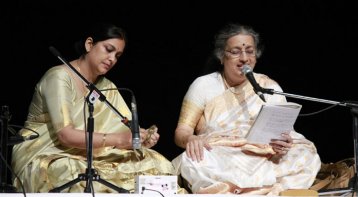 Ashwini Bhide Deshpande 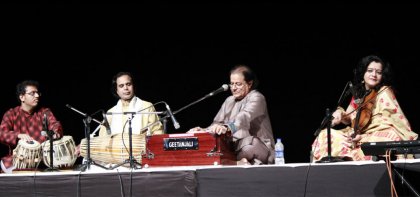 Anup Jalota 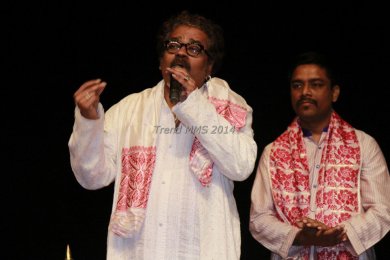 Hariharan 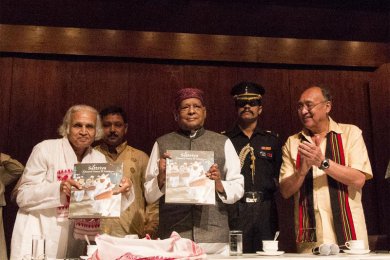 Governor of Assam releasing Sattriya: Classical Dance of Assam In the audience were present other dignitaries, among them singer Hariharan. He was invited on the stage to say a few words and he rendered Kannada song Krishna ni begane baro in his inimitable manner. The audience was in a receptive mood. Normally after such singing, generally no one is in mood to listen to a discourse on Sankaradeva. But to his credit, Victor Banerjee kept audience in thrall with his erudite scholarly, well documented presentation on Sankaradeva, taking into account other great religious leaders around the world in 15th century including the Pope and Guru Gobind Singh. Victor drew attention to the fact that both these preachers placed religious texts in the place of worship. Sankaradeva placed Srimad Bhagavatapurana on simhasana and Guru Gobind Singh Grantha Sahib in Gurudwara. Victor Banerjee holds a unique position in this movement. He has intimate association with the Dimasa Kacharis, one of the first Tibeto-Burman inhabitants of the Northeast hills who miraculously retain their culture, customs, religion and language. Victor was appointed as their Brand Ambassador earlier this year during their week-long Bushu Festival. It is an honour for him to represent such a tribe tucked away in Cachar Hills of Assam. Their folk culture is rich beyond expectations and belief. There were other dignitaries: Music director Lalit from Jatin-Lalit duo, music director Pritam, and the Assamese rock star Zubin Garg. The fusion of Naga and Assamese by Guru Reuban Masangva, Kalpana Patowary (she also sang Dr Bhupen Hazarika's most popular sing Ganga tum bahati ho kyun?). It was for the first time that Naga musician was performing in Mumbai and had travelled changing three planes to reach Mumbai from that distance. He regaled audience with his charming innocence and endearing personality, dressed in Naga costume. Audience asked for 'once more' and he did render one more song which brought down the house. 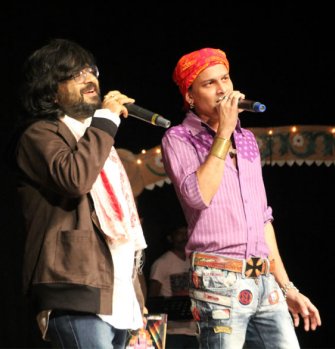 Rock star Zubin with music composer Pritam 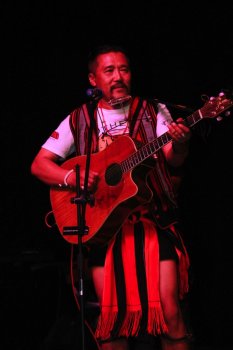 Naga Folk singer Reuban Masangva 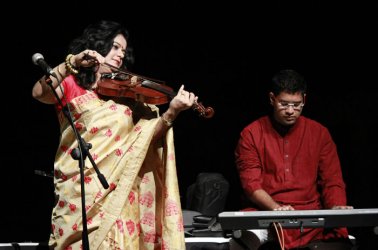 Violinist Sunita Khaund 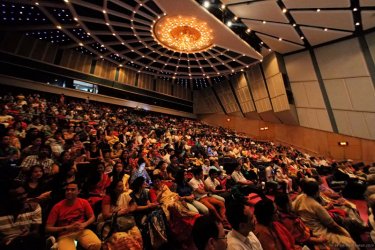 Large gathering at Jamshed Bhabha Auditorium The violinist Sunita Khaund is a charmer. All rounder, with excellent command over violin, as an accompanist and also as a soloist, she performed with ease. She has a star quality and attractive stage presence. She sang Assamese folk songs lustily, rendered Bihu dance movements easily, made audience join in clapping and arm movements used while dancing. She was a riot and proved that she is an artiste par excellence with mass appeal. The rock star young Zubin Garg was a big draw. The young and elders in the audience were eagerly waiting for him. Though it took quite some time to set musical instruments properly, the audience waited patiently. And he did not disappoint. The young crowd cheered him with joyous calls and he responded with equal enthusiasm. This variety programme was well devised with few breaks to honour the celebrities. The mood was of celebrations. Through songs, instrumental music, rock music, popular folk songs and giving glimpses of diverse culture of Assam, the message of Sankaradeva was communicated of universal brotherhood. It not only inspires hills and dales of Assam but has crossed those borders and through such movements spreads all over India.  Mallika Kandali as Yashoda telling story to child Krishna in Ankiya Nat of Madhavdev 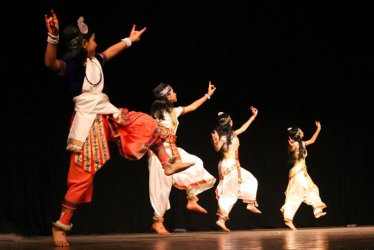 Krishna and his friends dancing in Chordhora, Ankiya Nat of Madhavdev The organization was mind boggling. The brothers Shyamkanu and Bhaskar Jyoti Mahanta and their entire team of workers left no stone unturned to make this event most memorable. I enjoyed it thoroughly and felt privileged to be a part of it and felt honoured that I was able to contribute to Sankaradeva's wonderful work by my book Sattriya: Classical Dance of Assam. It did reach out to the large Assamese community on this occasion.  Dr. Sunil Kothari is a dance historian, scholar, author and a renowned dance critic. He is Vice President of World Dance Alliance Asia Pacific India chapter, based in New Delhi. He is honored by the President of India with Padma Shri, Sangeet Natak Akademi award and Senior Critic Award from Dance Critics Association, NYC. He is a regular contributor to www.narthaki.com, the roving critic for monthly magazine Sruti and is a contributing editor of Nartanam for the past 12 years. Post your comments Pl provide your name and email id along with your comment. All appropriate comments posted with name and email id in the blog will also be featured in the site. |